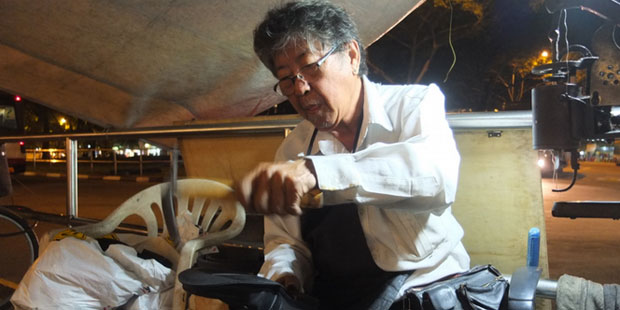It’s a Monday evening and the crowd at Yishun Bus Interchange is starting to swell. As usual.
Lines begin to snake, buses roar and commuters are either eager to go home or transfixed on their mobile phones, paying short shrift to Yamaguchi Taro.
But when they require his services, they can locate him better than a GPS. The 65-year-old is a permanent fixture in Yishun: He has been mending shoes by the bus interchange for 21 years. Continuously. He works daily from 1.30 p.m. to 11.30 p.m. and his only break comes during the Chinese New Year, when he takes two weeks off from the long hours expected of the job and the exhaust fumes of buses.
Not that he’s complaining.

He tells Mothership in Mandarin: [quip float="pqright"]"I’m used to working for long hours. People from my generation are used to being tired. We’ve been tired forever. It’s not good to rest you know -– that means I have no job!"[/quip] Despite the Japanese name (he has a Japanese dad), the sexagenarian is also fluent in Malay and English, switching effortlessly to converse with his many customers.
Yamaguchi is one of the few street cobblers left in Singapore. Once a common sight, they are now a rare breed whose market share has been slowly eroded by chain shops, such as Shukey, which repair shoes. He estimates that there are fewer than 300 street cobblers in Singapore and said that the authorities have stopped handing out licenses to street cobblers. Eventually, he laments, there will be none left.
Whatever competition from commercialised shops, he takes it in his stride. “For the same job, I charge $10 but they can charge some $40. Sometimes, it’s even more expensive than the cost of the shoes. The customers will come to me eventually.” The 65-year-old’s rates for shoe repair vary from as low as $2 to $450, which is the cost for stitching leather soles onto a pair of Louis Vuitton heels. On average, he mends 20 shoes daily. For someone to entrust him with a pair of heels costing at least a thousand dollars, his workmanship is obviously of a certain quality.

How Yamaguchi honed his skills is as surprising as where he did it. His first job was an apprentice in a shoe-making factory and he spent his formative years there. He was only 12 years old. He left when he was 18 and went on to become a carpenter, carving decorations for Chinese Garden. He became an electrician next, and finally, a cobbler at Cobbler Square in Chinatown.
“There were some 17 cobblers there and it was hard for me. Plus, I wanted to be independent. That’s why I landed up in Yishun after two years there,” he says. It wasn’t easy for him from the start. He used to stay in Queenstown and easily spent three hours traveling to and fro on his motorcycle. Now, the three hours are shortened to just three bus stops: He has adapted to the town and has been living in Yishun for three years.

Although street cobblers are in short supply, he’s happy that both his daughters, aged 39 and 35, are learning the trade from him and are now helping out at the stall on a part time basis. They have a plan to strike out on their own and open a shop at a HDB block. But Yamaguchi will not leave his beloved stall that he built with his bare hands. Yes, he literally constructed his own shelves and drawers.
He says: “I will still carry on here even though they have their own shop.”
The attachment to Yishun is unmistakable. After all, he has spent some 21 years there. From just a terminal MRT station to a bustling northern town with an expanded Northpoint Shopping Centre, he has seen it all. Yet, he looks forward to his daily date with the snaking queues, roaring buses and his beloved stall.
If you like what you read, follow us on Facebook, Instagram, Twitter and Telegram to get the latest updates.
